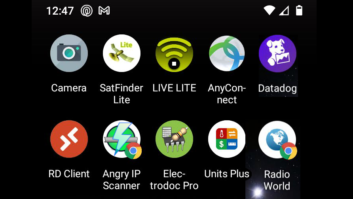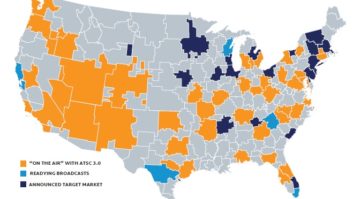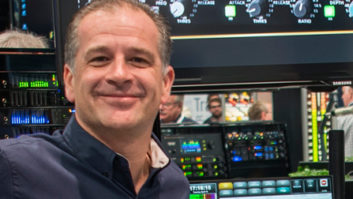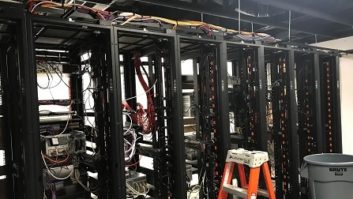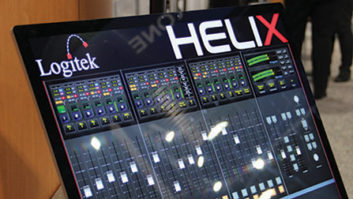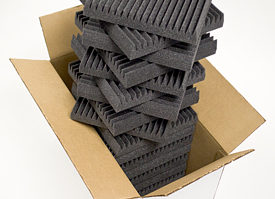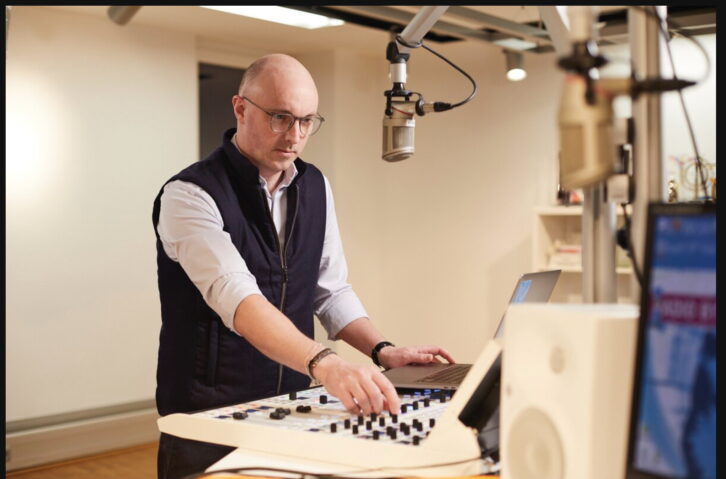
A current Radio World ebook explores trends in the development of consoles and mixers.
Johan Boqvist’s title at Lawo is “product evangelist, audio infrastructure.” He is part of its product management team for audio products and solutions and has experience at Swedish Radio, the Audio Engineering Society and the European Broadcasting Union.
Radio World: What do you consider to be the most important trend in console design.
Johan Boqvist: The trend right now is for consoles to have scalable and consistent hybrid human interfaces that adapt to a range of operators, from sound engineers to self-op on-air talents. When we say “hybrid,” we mean combining the reliability of physical, tactile controls like pushbuttons, faders and knobs with the adaptability of a virtual touchscreen interface. This combination allows broadcasters to personalize workflows for specific users and production scenarios without sacrificing the reliability of physical controls needed in live air situations.
Scalability is another essential factor, allowing consoles to be used in setups ranging from a small podcast studio with two channels to a fully equipped production environment with hundreds of input channels. The key is consistency across design and workflow principles throughout the range of product lines, enabling operators to transition between studios without the need for extensive retraining. By unifying these elements, Lawo creates consoles that adapt to diverse studio needs while upholding the consistency and ease of use essential for ambitious live on-air productions.
RW: Are there important capabilities that have emerged in the past couple of years?
Boqvist: Absolutely. The move to IP-native surfaces and audio over IP was revolutionary, and so was the recent shift towards CPU-based processing hosted on standard servers instead of dedicated hardware appliance.
This has opened up a more scalable, flexible infrastructure that’s easier to maintain and, perhaps even more important, supports a smaller carbon footprint due to its efficient use of computing resources. CPU-based processing allows to scale computing power up or down on demand, reducing energy consumption and providing flexibility that aligns with modern IT expectations.
This shift allows broadcasters to adapt dynamically to production requirements, utilizing processing power only when needed and reducing overall environmental impact — a critical consideration as sustainability becomes increasingly important for broadcasters.
[Related: “Three Key Trends for the Future of Radio”]
RW: What is the definition of a radio audio console now?
Boqvist: A radio audio console today consists of three core pillars.
I/O or Input/Output is where the console connects to other studio audio equipment and subscribes to resources and streams available on the network.
Processing is a backend service that processes and blends individual audio sources using DSP, creating the unique sound profile for each radio station.
And Human Interface is where the magic happens, where operators orchestrate, adjust and balance audio sources, by using different types of interfaces, like physical console surfaces, virtual interfaces or hybrid setups. Human interfaces can range from smartphone apps to 36-fader mixing consoles or larger.
At Lawo, we offer these components as modular products that can function independently or as a bundled package for streamlined setup and maintenance. This approach allows for custom configurations, integrating existing audio infrastructure with optimized workflows and technology. Radio broadcasting has a long history and deep-rooted, elaborate workflows, and our solutions respect that history while offering the flexibility to evolve.
RW: What will the console of the future look like, if we use one at all?
Boqvist: We believe we are on the right path here with a “Lego” approach on how to build consoles. There will always be a need for audio consoles: Innovations in audio processing and AI technologies will most likely change the workflow of users “pushing faders” for different production scenarios, but physical faders and tactile controls will remain essential especially for challenging, fast-paced live broadcasts. It’s a bit like self-driving cars: Even if technology can handle routine operations, there will always be a need for human oversight and the ability to make manual adjustments. Audio consoles will evolve to integrate more automation and AI-driven features but will retain physical controls for those high-stakes, nuanced operations that require direct human input.
RW: What are the implications of software- and cloud-based mixing today or down the road, for how stations use consoles and surfaces?
Boqvist: It opens up incredible flexibility but also introduces challenges. Latency can be unpredictable, depending on the user’s connection to the cloud and the location of the server. Security is another major concern, especially for state-owned or public broadcasters that are wary of placing sensitive content in the public cloud. There are solutions for this, but the customers need to carefully balance the pros and cons when considering a cloud-based audio infrastructure.
Our latest products are built with cloud-native technology, allowing them to run on-premises servers (a private cloud) or in the public cloud if the broadcaster chooses. This flexibility lets broadcasters decide the best fit for their security needs while taking advantage of cloud technology’s agility and scalability.
RW: How has the evolution of consoles changed how engineers view them and plan installations?
Boqvist: The introduction of AoIP standards like AES67 and ST 2110 over the past decade has fundamentally changed radio broadcast infrastructure. These standards allow audio to be transported across a network, making it possible to manage broadcast infrastructure over a country or even across and between continents. Now, IP-native consoles and virtual interfaces enable broadcasts from practically anywhere with internet access. Combined, this has drastically changed how radio engineers design their systems.
With IP-based broadcasting, the industry is moving toward decoupling container-based processing from physical hardware. This approach offers scalability and flexibility, allowing broadcasters to adopt server-based architectures that future-proof their systems while enhancing security and resource management. And watch out for the “second wave” of the broadcast industry’s IP journey that has just started, allowing the manufacturers to develop and offer software applications that can be installed to any COTS server engine providing the computing power needed, offering next-generation benefits.
RW: What is the state of “interoperability” with AoIP-based consoles?
Boqvist: This has improved greatly in recent years. The trend is that almost all professional broadcast consoles now support AES67 and ST 2110, with varying methods for stream announcement and management, such as Ravenna, Livewire+ and Dante. This allows for true interoperability between vendors. Different brands are capable to interoperate, allowing broadcasters to mix and match equipment.
Many broadcasters also use NMOS IS-04 and IS-05 protocols for discovery and stream management, being able of sharing radio and TV infrastructures. Lawo’s HOME platform further enhances interoperability, serving as a central hub that unifies products supporting Ravenna, NMOS and Dante, streamlining management and coordination across different manufacturers’ devices.
RW: Tell us about a notable recent project.
Boqvist: RTL Belgium’s recent installation is a great example. They embraced Lawo’s IP-native technology to completely rethink their broadcast landscape. By centralizing resources and deploying AoIP solutions, RTL Belgium has set up a flexible, efficient infrastructure that can scale with future growth. Lawo’s HOME platform is central to this setup, providing robust management and security across their network while making it easier to add new features or expand when needed. RTL Belgium’s approach is a forward-looking example of how broadcasters can use IP technology to stay agile and resilient. You can learn more at this link.
RW: What demands do you hear from potential buyers that are different from 10 or 15 years ago?
Boqvist: Today’s buyers look for centralized and shared resources, such as DSP and playout systems, that can be managed remotely. There’s also a growing demand for advanced IT security protocols to protect operations across unmanaged networks like the internet, especially as remote production becomes more common.
RW: What does the next generation of user interface look like?
Boqvist: For us, intuitiveness and consistency combined with design and workflow principles are very strong objectives. We have seen to many “lift-and-shift” iterations in the market lately, “virtual consoles” presented as graphical user interface, representing channel strips and central modules as they were a physical console. We truly believe in simplicity and tailored user interfaces for the application, based on a common design system and workflow principles. This allows users to transition seamlessly from different type of production environments without additional training for specific tools.
RW: Any tips for someone s setting out to make a buying decision?
Boqvist: Choosing a scalable system, one that can grow and adapt as your needs evolve — in your production environment and regarding an optimal economic solution. Lawo’s Flex model, for example, combines perpetual software licenses with flexible subscriptions, giving broadcasters the ability to expand or contract their resources as required. With a flexible subscription model, broadcasters can return unused resources to their wallet and redeploy them where they’re most needed, making the infrastructure adaptable and cost-effective.
RW: What else should we know?
Boqvist: After the “first wave” of innovation in live media production workflows by applying software-defined infrastructure, the “second wave” of IP audio infrastructure isn’t just on the horizon, it’s here. In the second wave, microservices and container-based processing play a central role, allowing individual components of broadcast workflows — like audio mixing, processing, and routing — to be managed independently and scaled up or down as needed using computing power of COTS servers dedicated for high-performance computing.
This granular approach supports greater flexibility and resource management, enabling broadcasters to adapt swiftly to changing production demands without overhauling entire systems. It also means that each component can be securely updated and maintained without disrupting the whole infrastructure, minimizing downtime and enhancing security.
